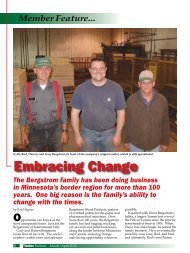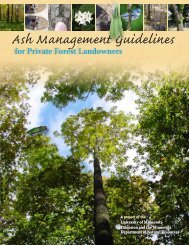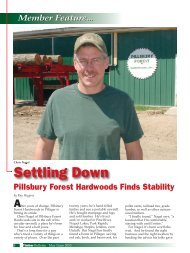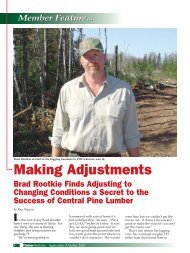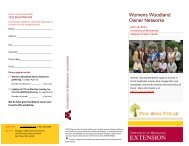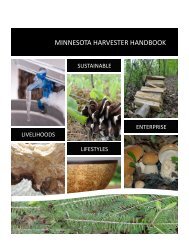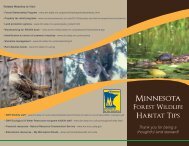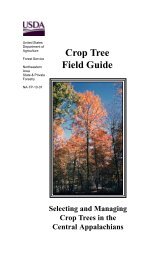Ash Management Guide for Private Forest Landowners
Ash Management Guide for Private Forest Landowners
Ash Management Guide for Private Forest Landowners
Create successful ePaper yourself
Turn your PDF publications into a flip-book with our unique Google optimized e-Paper software.
The Delphi Survey ProcessThe University of Minnesota Extensionand the MN Department of Natural Resources(DNR) recognized a need to offer practical andtimely ash management recommendations <strong>for</strong>family <strong>for</strong>est landowners in the emerald ashborer (EAB) era. However because EAB is sucha new pest, first discovered in Michigan in 2002,and trees grow slowly – the average life spanof an ash is 200 years – and science takes time;we were tasked with the nearly impossible: topredict the future. We did our best to make recommendationsto manage <strong>for</strong> this uncertainty.Extension took the lead in exploring options onthe best way to predict and plan <strong>for</strong> an unknownfuture. After much consideration and consultationwith Extension’s evaluation experts, a surveyprocess called a modified-Delphi was chosen.This process is a systematic, interactive, anonymous,structured survey method to facilitate apanel of experts to offer recommendations oropinions from many areas of expertise.For this <strong>Ash</strong> <strong>Management</strong> project Extensionfacilitated three rounds of the modified-Delphisurvey. Of the 31 participants not all participatedin each round. This process was extensive, Round1 (84% response rate), consisted of 19 open endquestions. Participants were given two weeks tocontribute to the survey. Following those twoweeks Extension had two weeks to tally surveyresponses and create the next round of thesurvey based on feedback offered in the previousround. Round 2 (81% response rate) waslarge, 103 questions all generated from Round1. Round 3 included all the results from Round2 plus new in<strong>for</strong>mation generated in Round 2.In total, Round 3 (68% response rate) was 98questions. The results of this survey processare wide reaching, but they are not exhaustive.When consensus couldn’t be reached we didn’treport that recommendation. It is very importantto remember that none of us has a crystal ballwhich we can see the future of Minnesota’s ash<strong>for</strong>ests. This is our best ef<strong>for</strong>t to find a methodand experts to offer help. However it will be veryimportant <strong>for</strong> everyone, landowners and naturalresource professionals alike, to stay abreastof current research and in<strong>for</strong>mation becauserecommendations are likely to change as the sciencescatches up.Forty-one experts, mostly from Minnesota,were asked to participate. They were experts insilviculture, <strong>for</strong>est hydrology, the MN DNR’s ecosystemclassification system, timber harvesting,family <strong>for</strong>est landowners, <strong>for</strong>est regeneration,<strong>for</strong>ests and climate change, wood utilization andlogging, <strong>for</strong>est wildlife, woodland communication,EAB quarantine, EAB, cultural aspects ofash, and <strong>for</strong>est genetics. Deliberate ef<strong>for</strong>t wasmade to find experts from different organizationsincluding the University of Minnesota, DNR,US <strong>Forest</strong> Service, private industry, Bureau ofIndian Affairs, Minnesota counties, and privatelandowners. However, survey facilitators hadlittle control over who actually participated inthe survey. Of the 41 invited to participate 31actually contributed in any of the three rounds.All response rates are based on the 31 expertsthat actually participated in at least one of therounds.Funding and resources <strong>for</strong> this project,beyond the valuable and extensive time contributedby the panel of experts, were offered bythe University of Minnesota Extension, the MNDepartment of Natural Resources, <strong>Forest</strong> StewardshipFunding, and the Renewable ResourcesExtension Act.3



